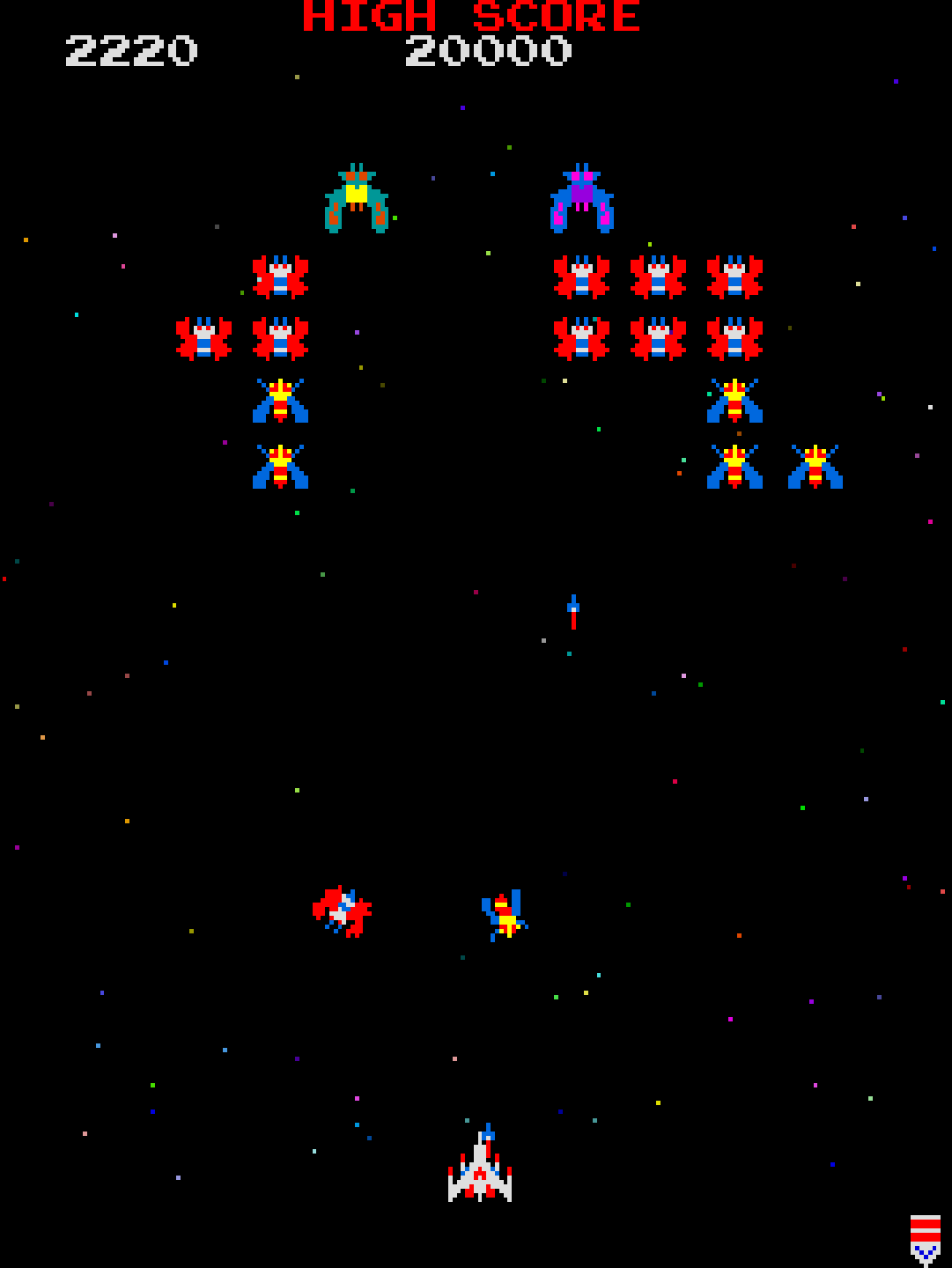Introduction: A Game of Survival—On Screen and Off
When Namco released Galaga in 1981, the arcade world was shifting beneath developers’ feet. Just three years after Taito’s Space Invaders triggered the first global video game craze, the market was showing signs of saturation. Coin-op vendors struggled to recoup their investments, arcades were cluttered with clones, and profits were dipping. Into this turbulent climate emerged a space shooter that didn’t just build on its predecessor Galaxian—it refined, reinvented, and ultimately anchored an entire era.
Galaga became a cabinet you could still find running two decades later. It birthed mechanics copied by generations of developers, introduced one of the first purposeful power-up systems, and delivered design elegance that has yet to be eclipsed. But the path to Galaga’s legacy was anything but linear. This is the story of how a risky experiment, forged from leftover hardware, a forgotten sci-fi film, and a programming bug, turned into one of the most beloved arcade games of all time.

1. The Pre-Galaga Landscape: A Fragile Market and a Company on the Rise
In the late 1970s, Namco had just begun its push into the arcade market. The company had acquired Atari’s Japanese division and released its first original title, Gee Bee, in 1978. Space Invaders had exploded that same year, changing the landscape. But the volatility of early success was already clear.
"Back in those early days... games would sell well for the first 1 or 2 months after they released, but fall off quickly after that. You’d often hear vendors talk about how video games just were not profitable."
—Akiyoshi Sarukawa, Head of Domestic Sales
This wasn’t just market anxiety. It was existential. Machines like Galaxian and Pac-Man became financial lifelines not only for Namco, but for operators who still hadn’t paid off their Space Invaders units.
“The bill for SPACE INVADERS had to be paid off with revenue from games such as Galaxian and PAC-MAN... So what we did was try and reduce payment periods, take collateral, ask for co-signers... This gave us a soft landing without any major issues.”
—Akiyoshi Sarukawa
Namco’s philosophy became clear: innovate quickly, produce efficiently, and capture attention fast. Galaxian delivered a stunning leap with full-color graphics and dynamic attack waves.
“I must say that Galaxian was a far superior game. The Invader game was black and white... Galaxian was in color and the enemies attack from various directions. So it was a significant improvement.”
—Masaya Nakamura, Founder of Namco
Galaga was next—but its origin wasn’t originally about sequelization. It began with hardware reuse.
“We had already made Galaxian by that point, so while the game was still in the planning stages, we reused hardware from that.”
—Shigeichi Ishimura, Board Designer

2. Design by Accident, Refinement by Obsession
Galaga began development on leftover Galaxian boards, but when Namco’s R&D team committed to designing a new board, the project was restarted with new capabilities—and more ambitious ideas.
“At first, we based our development off of the Galaxian board... but Ishimura-san... mentioned they were going to develop a new board. When we heard that, we decided to go back to the drawing board.”
—Shigeru Yokoyama, Game Designer
One of Galaga’s most iconic features—the tractor beam and Dual Fighter mode—didn’t exist at first. It arose out of a creative crisis.
“The appeal of Galaxian is that you could maneuver through enemy fire... but it wouldn’t differentiate the game from Galaxian. That’s when I came up with an idea of having the enemies conduct a different method of attack... I saw beams being fired [in a movie]... why not have the enemies shoot a beam that doesn’t simply destroy, but rather captures their target?”
—Shigeru Yokoyama
The mechanic evolved from a simple capture-and-return system to the groundbreaking concept of fusing your rescued ship into a more powerful dual-firing unit.
“I initially thought of rescuing the spacefighter and putting it back into the player’s stock (life)... but that wouldn’t be any different from Extend, so then I came up with the Dual Fighter mode.”
—Shigeru Yokoyama
The Dual Fighter concept introduced strategic risk and reward—but it also presented technical challenges. The sprite limit meant two missiles couldn’t be drawn separately. The team faked it with pixel trickery:
“We simply decided to write 2 missiles within the sprite’s 16x16 dot.”
—Shigeru Yokoyama
This had consequences: larger hitboxes meant higher risk, and few players used the feature early on. But it paid off during the new “Challenging Stage,” where players could fire freely without enemy retaliation.
“So creation of the Challenging Stage balanced out the purpose of using Dual Fighter mode.”
—Shigeru Yokoyama
How was the Challenging Stage invented? A bug.
“Ogawa-san caused a bug which made the enemy formation simply fly off the screen... we discussed that it could be fun shooting them as they showed up, and decided to make this into the Challenging Stage.”
—Shigeru Yokoyama

3. Cabinet Wars, Control Panels, and Internal Resistance
While the game’s code was taking shape, Yokoyama found himself in a very different battle—with Namco’s cabinet designers. The default upright control panel wasn’t suited for Galaga’s fast-paced gameplay.
“Before Galaga... the buttons and joystick were designed upright onto the table cabinet. But... that made the button difficult to press... I had a discussion with the experts... to apply a horizontal design.”
—Shigeru Yokoyama
He was nearly overruled.
“I was thoroughly scolded by a certain someone for adopting that cabinet, being told that ‘there’s no way it’ll sell.’ In fact, I was also told to change it back... I’m sure glad I didn’t cave in then.”
—Shigeru Yokoyama
Today, that horizontal layout is standard, and Galaga helped popularize it.

4. Testing the Waters: Risky Location Tests and Long Playtimes
Once development finished, Yokoyama had little concern for deadlines or corporate profit. He worked intuitively, building schedules backwards from the manufacturing phase.
“To be honest, I had no interest whatsoever of company interests or profit. In fact, I never once even considered it.”
—Shigeru Yokoyama
That mindset didn’t calm nerves when Galaga’s location tests showed low earnings.
“It took an average of 7 to 8 minutes. That was why the turnaround in income wasn’t great... I recall being complained about it.”
—Shigeru Yokoyama
The average arcade game was built for 3-minute loops. Galaga offered double the length—but that turned into a long-term asset. It wasn’t about burning quarters—it was about keeping people coming back.
“Players would play the game for a long time... so I asked that the game be released as-is.”
—Shigeru Yokoyama
Namco listened. And in hindsight, Galaga became one of the most enduring and profitable cabinets of its generation.
5. The Namco Philosophy: Collaboration and Detail Above All
Yokoyama’s story is one of collaboration. He constantly cites Ogawa (programming), Ohno (graphics), and Ishimura (hardware) as key contributors. He also speaks to Namco’s deeper DNA:
“We always put out our very best. That applies to every bit of data available, which is why I test everything to whatever extent possible. Either that or I simulate things on my own... This stance isn’t something of choice by creators.”
—Shigeru Yokoyama
Even the instruction card sparked heated debate.
“We had a huge argument over the wording here... Nakamura-san was very particular... each time I took it to his office he would tell me ‘no.’ After how many times I bothered him, in the end, he told me to stop goofing off.”
—Shigeru Yokoyama
The level of care in Galaga’s every detail—from control panels to UI language—was unprecedented. So was its playability. In internal tests, it appealed across gender and skill.
“Even our non-gamer girls had fun playing the game, more in relation as being a stress reliever.”
—Shigeru Yokoyama

6. The Legacy: A Game Without a Character, But With a Soul
Galaga may not have had a central mascot like Pac-Man, but it had something else—universal recognition and replayability.
“In particular, I was very happy when I was told by a middle-aged female bus guide that she knew about Galaga... That’s when it hit me that, ‘that’s right, the game is pretty popular’ (laughs).”
—Shigeru Yokoyama
Unlike Pac-Man, Galaga’s brand was open-ended.
“Galaga is a non-character based game... so I’ve got no issues on how those are used or improvised (laughs).”
—Shigeru Yokoyama
Despite being minimalistic, Galaga was already complete:
“What is out there now is complete. I think that’s the same for Pac-man, too.”
—Shigeru Yokoyama
Conclusion: From Risk to Refinement to Reverence
Galaga wasn’t a sequel. It was a redefinition. Built from scraps of Galaxian boards and sparked by cinematic inspiration, it took bold mechanical risks while navigating the commercial pressure of a market in decline. Through a collaborative development process and uncompromising attention to detail, it delivered one of the most finely tuned, satisfying, and timeless arcade games ever made.
And more than four decades later, it still lives—not just in remakes and compilations—but in the memory of players, the rhythm of rapid-fire shots, and the silhouette of a ship once caught in a beam.
Sources & Further Reading
- Bandai Namco’s official 40th anniversary developer interviews (Parts 1–3)
- The Ultimate History of Video Games (Steven L. Kent)
- Galaga.com's Mr. Shigeru Yokoyama interview volume 1 & 2.
- Attract Mode (Jamie Lendino)
- Arcade Mania! by Brian Ashcraft
Want to Go Deeper Into Arcade History?
If this Galaga article left you craving more, dive into the complete stories behind some of the most iconic arcade genres and franchises. These articles explore the rise, innovation, and legacy of the games that shaped arcade culture:
- Donkey Kong’s Rise to Fame: How a Desperate Bet Created a Gaming Legend – The untold story of how Nintendo turned failure into a global icon, launching Mario, Miyamoto, and a new era of arcade storytelling
- What Makes an Arcade Game Great? – A deep dive into the design principles behind the most unforgettable cabinets of all time
- Inside the Metal Slug Legacy: The Developers Who Made It a Classic – How a small team at Nazca crafted one of the most iconic run-and-gun series of all time.
- The Complete History of Mortal Kombat Arcade – How a gritty fighter became a pop culture phenomenon.
- Capcom’s 19XX Series: The Complete History – The vertical shooters that defined a generation of arcade firepower.
- The History of Beat ’Em Up Arcade Games – From Double Dragon to Final Fight, here’s how brawlers ruled the late ’80s.
- The Complete History of Space Shooter Arcade Games – The genre that launched arcades into orbit.
- The King of Fighters Legacy: Inside SNK’s Genre-Defining Saga – How SNK’s 3v3 fighter evolved from a crossover gamble into one of the deepest and most beloved fighting franchises in the world.
- Defender: The Game That Changed Everything – How a risky bet and a radical vision helped redefine arcade design forever.

